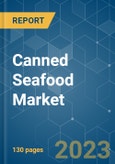The canned seafood market is majorly driven by the growing demand for ready-to-cook food products and the innovations in canning technologies, which have led to the introduction of diverse products in the market and ensured a bigger consumer base. Furthermore, developing value-added seafood products is another strategy key players adopt to cater to the increased demand in the market. For instance, Pacific Seafood offers a value-added line of canned, frozen, and seasoned raw warm water shrimp infused with whey to enhance the potassium and calcium contents of the product.
Similarly, the sale of canned seafood products, particularly canned tuna, increased as the long shelf life of such products appealed to consumers subjected to home quarantines, regulatory measures restricting ease of movement, and other impacts of the COVID-19 pandemic. The rising awareness about the health benefits offered by canned seafood products is increasing the growth of the canned seafood market. Canned seafood is an excellent source of omega-3 fatty acids, which are important for overall health and well-being. The demand for conspicuous and exotic food items is on the rise as a result of the rising purchasing power of consumers. Therefore, the aforementioned factors are expected to fuel the growth of the canned seafood market over the forecast period.
Canned Seafood Market Trends
Growing Preference for Convenience Food
The key factors driving the growth of canned seafood consumption are convenience, increasing disposable income, and a rising number of working women. Changes in lifestyles and increased expenditure on food and beverages lead to significant dietary transitions among consumers, marked by the increased demand for animal-sourced food, fats and oils, refined grains, and fruits and vegetables. People with hectic schedules, those who lack cooking skills and suffer from fatigue due to their fast-paced lifestyles, and changes in consumer demographics are the major factors driving the canned seafood market. Furthermore, the COVID-19 pandemic encouraged consumers to consume convenience foods, such as canned seafood, as lockdowns impacted the supply of fresh food. The importance of long-shelf-life food was paramount during this period. Besides convenience, the sustainability factor of canned seafood also facilitates their sales. Metal is the preferred packaging material for canned foods because it is known to be the most effective in preserving food quality and is 100% recyclable. Furthermore, metal is the only material that completely blocks light and oxygen from entering the package, serving as an excellent barrier.Europe Accounted for the Largest Share
The region's high demand for ready-to-eat meals and seafood products propels the market growth. Furthermore, demand for long-lasting seafood products is expected to boost canned seafood consumption. The presence of major market players in the region and shifting consumer preferences toward ready-to-eat food are expected to drive market growth in the coming years. People's increased seafood consumption due to its numerous health benefits is expected to propel the industry's growth. Similarly, manufacturers are innovating in canned seafood products, which attract a larger consumer base. For instance, in October 2021, Mitch and Rockfish launched Rockfish Tinned Seafood, a British product that is made using fresh seafood direct from the South Coast of England. The tin is artfully packaged with bold and colorful modern designs.Canned Seafood Industry Overview
The canned seafood market is highly competitive, with major players investing heavily in product development by strengthening their research and development initiatives for the long term. Strategic alliances and agreements with regional players are also some of the approaches preferred by manufacturers to increase their revenue and widen their geographical presence. With growing income levels and an increasing level of knowledge regarding the consumption of healthy food in these economies, companies are catering to the dynamic needs of the people for canned seafood around the world. The major players in the market are Thai Union Group, Bumble Bee Foods LLC, and Maruha Nichiro Corporation.Moreover, key players have also been focusing on the sustainable production of seafood products to entice more consumers. Thus, players have invested huge capital in improving their processing techniques and certification processes to produce higher-quality products. For instance, in March 2021, Rio Mare, a Bolton Group brand, received EPD certification (Environmental Product Declaration) from DNV, an international certification body, becoming the world's first seafood brand with this certification.
Additional Benefits:
- The market estimate (ME) sheet in Excel format
- 3 months of analyst support
This product will be delivered within 2 business days.
Table of Contents
Companies Mentioned (Partial List)
A selection of companies mentioned in this report includes, but is not limited to:
- Americana Group Inc. (California Garden)
- Thai Union Group (John West)
- Century Pacific Food Inc.
- Bolton Group (Rio Mare)
- Okam
- Dhofar Fisheries and Food Co. SAOG
- Dongwon Group
- Carvalho Fisheries
- Maldives Industrial Fisheries Company Limited (MIFCO)
- Jim Pattison Group Inc
- FCF Co. Ltd (Bumble Bee Foods LLC)
- Trident Seafoods Corporation








